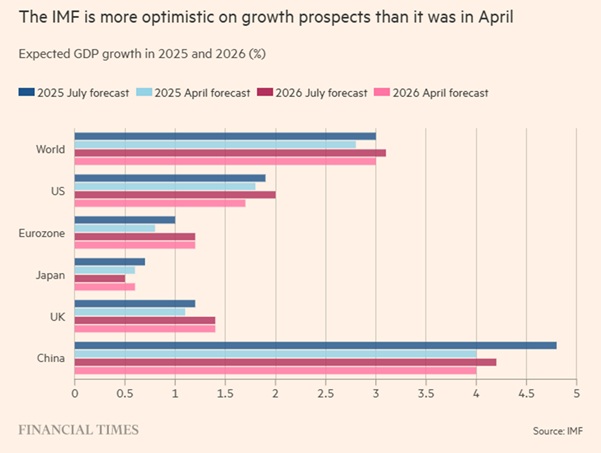Quick Bite – IMF upgrades global growth forecasts
The International Monetary Fund has upgraded its global growth forecast amid signs that President Trump’s trade war will do less damage to the world economy than initially feared, with a weaker dollar cushioning the impact of tariffs on US trading partners.
The Fund’s updated World Economic Outlook shows that global growth is expected to be 3% this year and 3.1% in 2026, up from previous projections published in April of 2.8% and 3%, respectively.
The world’s two largest economies, the US and China, both also received upgrades as did Australia. The IMF’s chief economist said that he saw a “tenuous resilience” in the global economy despite the chaotic rollout of steep tariffs on US trading partners in recent months. He added that growth was less affected because many of the levies were ultimately not as severe as originally planned.

Source: IMF, FT
“Global growth is projected at 3.0 percent for 2025 and 3.1 percent in 2026. The forecast for 2025 is 0.2 percentage point higher than that in the reference forecast of the April 2025 World Economic Outlook (WEO) and 0.1 percentage point higher for 2026. This reflects stronger-than-expected front-loading in anticipation of higher tariffs; lower average effective US tariff rates than announced in April; an improvement in financial conditions, including due to a weaker US dollar; and fiscal expansion in some major jurisdictions. Global headline inflation is expected to fall to 4.2 percent in 2025 and 3.6 percent in 2026, a path similar to the one projected in April. The overall picture hides notable cross-country differences, with forecasts predicting inflation will remain above target in the United States and be more subdued in other large economies.
“Risks to the outlook are tilted to the downside, as they were in the April 2025 WEO. A rebound in effective tariff rates could lead to weaker growth. Elevated uncertainty could start weighing more heavily on activity, also as deadlines for additional tariffs expire without progress on substantial, permanent agreements. Geopolitical tensions could disrupt global supply chains and push commodity prices up. Larger fiscal deficits or increased risk aversion could raise long-term interest rates and tighten global financial conditions. Combined with fragmentation concerns, this could reignite volatility in financial markets. On the upside, global growth could be lifted if trade negotiations lead to a predictable framework and to a decline in tariffs. Policies need to bring confidence, predictability, and sustainability by calming tensions, preserving price and financial stability, restoring fiscal buffers, and implementing much-needed structural reforms.” – International Monetary Fund, July 2025
At the time of their April forecast, the IMF had an effective tariff rate on imports into the US of 24%. Now they expect an effective tariff rate of 17%, thus an easing of the tariff pressure.
The IMF noted that companies “frontloading” imports ahead of the implementation of the new trade levies had boosted growth so far in 2025, but warned that this stockpiling created “exposures that could amplify the impact of any potential negative shocks”.
Weakness in the US dollar had also helped to prop up the world economy. The USD has slumped 9% this year against a basket of currencies including the euro and the pound on concerns over the trade war as well as the Federal Reserve’s independence. Since many foreign companies and emerging market economies have debt denominated in USD, depreciation makes that debt cheaper to service.
A decline in the USD has aided in easing global financial pressures.

Source: FT
The more optimistic forecast from the IMF marks a shift from its earlier outlook in April, in which it warned that the trade war risked pushing the global economy into a “significant slowdown”. However, the latest forecast would still mark a slowdown from 2024’s global economic growth of 3.3%. The average growth rate before the pandemic was 3.7%.
According to the IMF, emerging trade deals, including the long-awaited agreement reached with the EU most recently, were not yet sufficient to alleviate the uncertainty weighing on the global economy.
The IMF believes the US is now set to grow by 1.9% this year and 2% in 2026, compared with April’s estimates of 1.8% and 1.7%, respectively. China’s economic outlook for this year is set to be 0.8% better than predicted, with growth of 4.8% now expected by the fund.
The IMF slightly upgraded its forecasts for Australia’s real GDP growth in both 2025 and 2026. For this year, the forecasts were increased from 1.6% to 1.8%, and for next year, from 2.1% to 2.2%.
Global inflation is expected to continue to decline, with headline inflation falling to 4.2% in 2025 and 3.6% in 2026. This is virtually unchanged from the IMF’s April report, with trends of cooling demand and falling energy prices staying in place. The overall picture hides cross-country variation in forecasts, however. The tariffs, acting as a supply shock, are expected to pass through to US consumer prices gradually and hit inflation in the second half of 2025.





